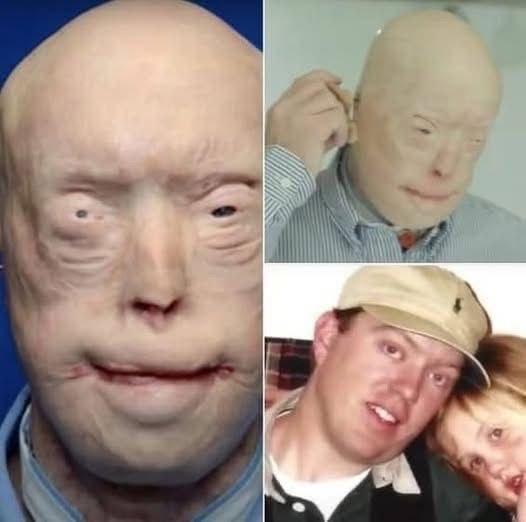Patrick Hardison never imagined he would become a symbol of resilience or the possibilities of modern medicine. He was simply a small-town volunteer firefighter from Mississippi, a husband and father who loved attending his children’s sporting events, working alongside neighbors, and serving his community. But one day in 2001 changed everything.
That day, Patrick bravely ran into a burning house after hearing that a woman might be trapped inside. The fire spread faster than anyone expected, and within minutes, Patrick was caught in the flames. He managed to escape, but the injuries were permanent and devastating—third-degree burns covered his face and scalp. He lost his ears, lips, most of his nose, and much of his eyelids, leaving his eyes painfully exposed.
For years afterward, Patrick lived with those injuries, and the toll was more than physical. He relied on a baseball cap, sunglasses, and prosthetic ears just to feel somewhat presentable in public. Yet the stares never stopped, and reactions were often harsh. He remembered children screaming or running away at the sight of him. Everyday moments became painfully challenging. “I’d walk into a store, and people would stop and stare. It wasn’t their fault, but I felt like a monster,” Patrick once said.
Life went on, but it was full of obstacles. Eating, drinking, even blinking were constant struggles. While his wife and children remained his strongest supporters, the emotional weight was crushing. Many might have given up—but Patrick did not.
Then, in 2015, he was offered something almost unimaginable: the chance to undergo the most extensive face transplant ever attempted. Doctors warned that the risks were high—he had, at most, a 50 percent chance of surviving. The operation required over 100 medical professionals, split into two teams, working for 26 continuous hours. It was both a medical gamble and a personal challenge.
Patrick decided to take the risk.
The donor was a young man who had died tragically, but his family chose to give the gift of life and identity to someone else. With their blessing, surgeons replaced Patrick’s scalp, ears, nose, lips, eyelids, and portions of his skull and jaw with donor tissue.
Miraculously, the surgery succeeded. For the first time in nearly 15 years, Patrick could close his eyes without pain. He could eat and drink normally. Most importantly, he could look at his reflection without flinching. The man who had hidden from the world for so long could now step back into it.
Recovery was not immediate. Months of rehabilitation, countless checkups, and a lifetime of anti-rejection medications became part of Patrick’s daily life. But he embraced it with the same determination that once drove him into a burning house to save a stranger. “I wanted to live for my kids,” he said. “They deserve a father who doesn’t give up.”
Today, years later, Patrick Hardison’s transformation is remarkable. He lives with his beloved wife and children, cherishing every ordinary moment many take for granted. He attends his children’s events without worrying about stares. He can smile, laugh, and blend into a crowd again.
Medical experts consider his case one of modern reconstructive surgery’s greatest achievements. Since the first partial face transplant performed on Isabelle Dinoire in France in 2005, the field has advanced rapidly, yet Patrick’s remains one of the most ambitious and successful procedures ever done.
Beyond the medical feat, Patrick’s journey is deeply human. He shows what true courage looks like—not only the courage to run into a burning building, but the courage to keep fighting when life leaves scars that most cannot imagine.
He has shared his story publicly, hoping to encourage others who feel broken or invisible. “I know what it’s like when people see only your scars,” Patrick said. “But I also know what it’s like to be given a second chance. I am living proof of what’s possible.”
Today, when people see him, they do not turn away. They lean in, ask questions, listen, and leave inspired. Patrick Hardison’s life is no longer defined by tragedy, but by survival, resilience, and hope.
And although he will forever carry the memory of that day in 2001, he also carries something greater: a new face, a renewed life, and the unshakable will to keep moving forward—for himself, his family, and anyone who needs to be reminded that miracles are possible.
